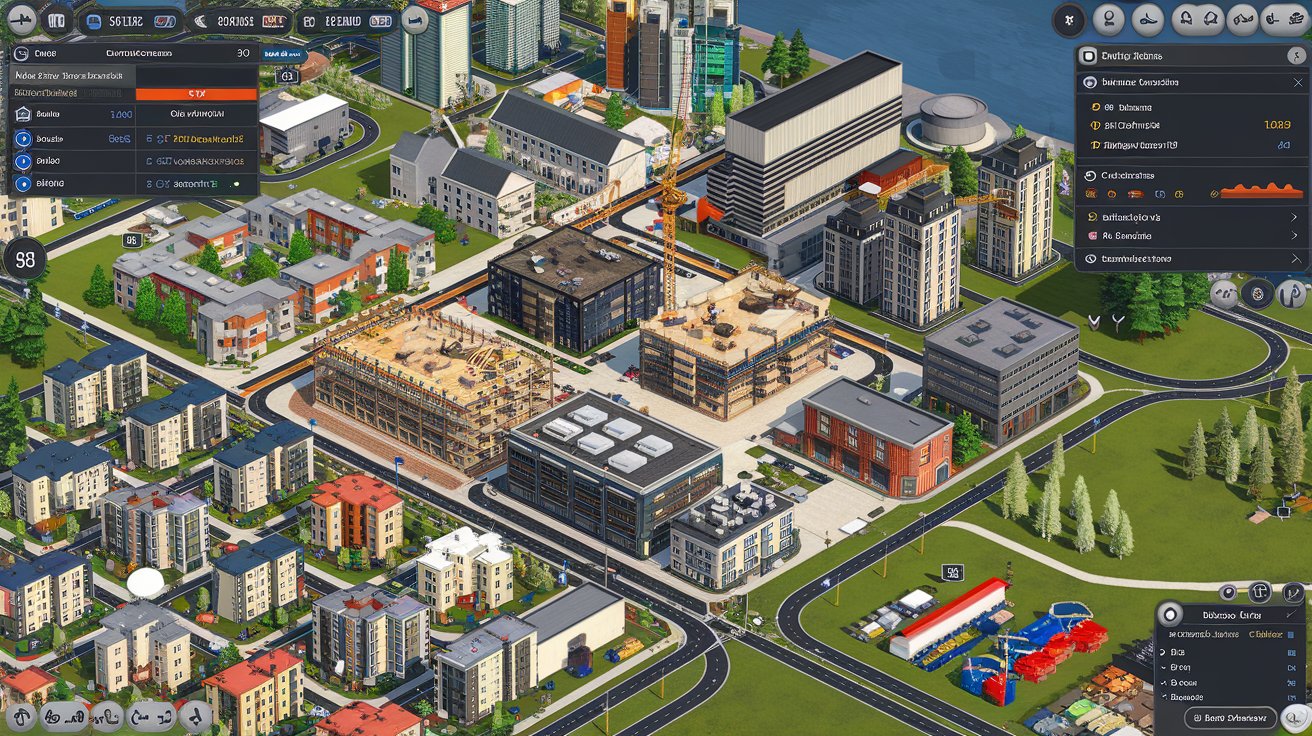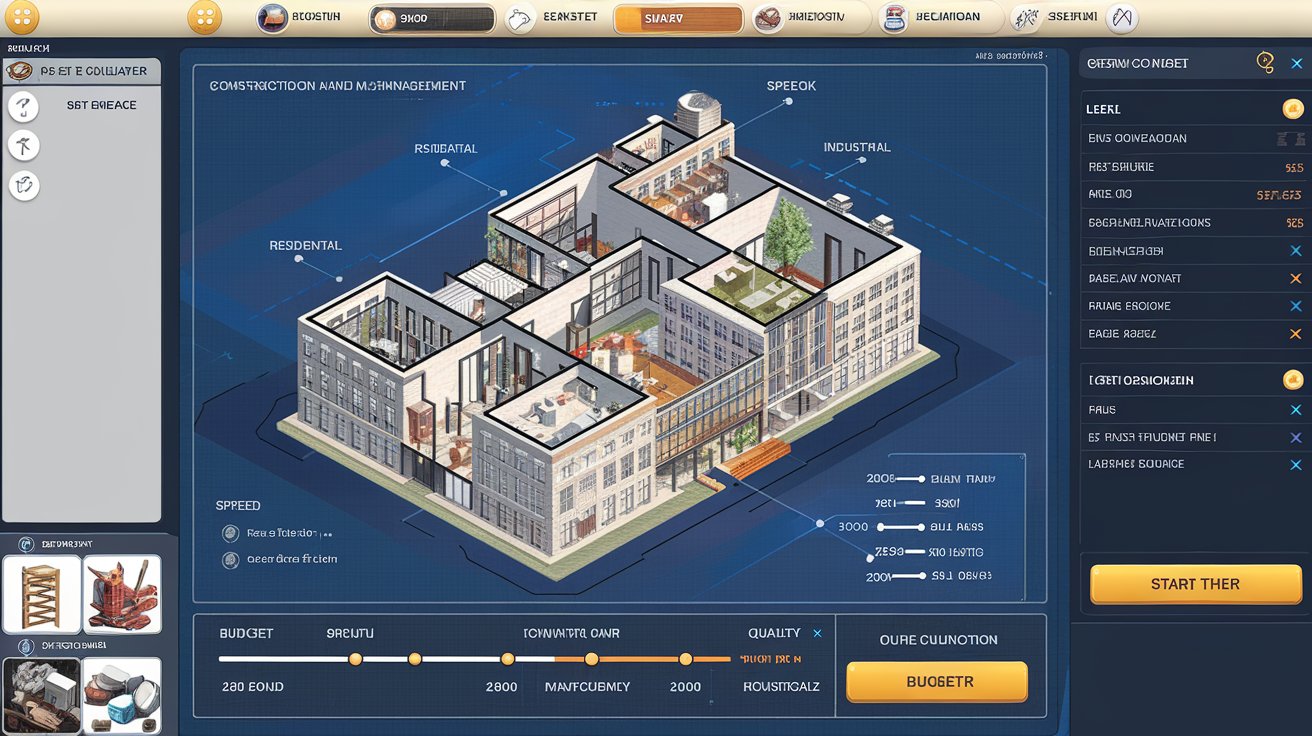In today’s fast-evolving digital landscape, construction and management simulation games have emerged as more than just entertainment—they’re powerful tools for learning, strategizing, and even dreaming big. Whether you’re a budding entrepreneur, a seasoned business owner, or simply someone fascinated by the art of building, these simulations offer a sandbox to test your skills, manage resources, and create a thriving virtual empire. From laying the first brick to overseeing a sprawling metropolis, construction and management simulations blend creativity with strategy, making them a unique gateway to understanding real-world business dynamics.
In this blog, we’ll explore how construction and management simulation games work, why they’re so addictive, and how they can teach you to build a successful business—both in-game and beyond. Let’s dive into the world of virtual construction and uncover the secrets to thriving in this exciting genre.
What Are Construction and Management Simulation Games?
Construction and management simulation games are a subgenre of strategy games where players take on the role of a builder, manager, or tycoon. These games task you with designing, constructing, and overseeing projects—ranging from individual buildings to entire cities or industries. Popular titles like SimCity, Cities: Skylines, RollerCoaster Tycoon, and Construction Simulator have captivated millions by blending creativity with resource management and problem-solving.
At their core, these games simulate real-world challenges: budgeting, planning, logistics, and customer satisfaction. You’re not just building structures—you’re managing economies, balancing supply chains, and ensuring your creations stand the test of time. Whether it’s keeping citizens happy in a bustling city or turning a profit on a construction site, the principles mirror those of running a real business.
Why Construction and Management Simulations Are So Addictive

What makes these games so hard to put down? It’s the perfect mix of control, creativity, and challenge. Here’s why players keep coming back:
- Creative Freedom: Want to build a towering skyscraper or a roller coaster that defies gravity? These games let you unleash your imagination with few limits.
- Strategic Depth: Every decision matters—allocate funds wisely, hire the right team, and plan for the long term, or watch your empire crumble.
- Instant Feedback: Unlike real life, where projects take months or years, simulations- Success feels rewarding, and failure teaches valuable lessons without real-world consequences.
- Realism Meets Fun: Modern simulations use stunning graphics, realistic physics, and intricate mechanics to immerse you in the experience.
This blend of fun and learning is why construction and management simulations appeal to gamers and aspiring entrepreneurs alike. They’re more than games—they’re training grounds for business success.
Key Elements of a Thriving Construction and Management Simulation
To succeed in these games (and in business), you need to master several core elements. Let’s break them down:
1. Resource Management
Every simulation revolves around resources: money, materials, time, and manpower. Mismanaging any of these can spell disaster. For example, in Cities: Skylines, overspending on infrastructure too early can bankrupt your city, while in Construction Simulator, running out of concrete mid-project stalls progress. The lesson? Prioritize needs, plan ahead, and keep a close eye on your bottom line.
Real-World Takeaway: Businesses thrive when resources are allocated efficiently. Track expenses, invest wisely, and always have a contingency plan.
2. Planning and Strategy
Before breaking ground, you need a vision. Will you focus on residential zones or industrial growth? How will you handle traffic flow or worker shortages? Successful players map out their goals and adapt as challenges arise.
Real-World Takeaway: A solid business plan is your blueprint. Anticipate obstacles, set milestones, and adjust your strategy as the market shifts.
3. Problem-Solving
Disasters happen—floods, equipment breakdowns, unhappy citizens. The best players tackle issues head-on, finding creative solutions to keep things running smoothly.
Real-World Takeaway: Resilience is key. When problems arise, analyze the situation, explore options, and act decisively.
4. Customer Satisfaction
In games like RollerCoaster Tycoon, happy guests mean more revenue. Neglect their needs, and your park empties out. The same applies to city-building games—keep residents happy with parks, schools, and jobs.
Real-World Takeaway: Put your customers first. A satisfied client base drives growth and loyalty.
5. Growth and Scaling
Start small, master the basics, then expand. Whether it’s adding a new ride or annexing land for your city, scaling too fast or too slow can disrupt your momentum.
Real-World Takeaway: Grow sustainably. Build a strong foundation before taking on bigger challenges.
How to Build a Thriving Business in Construction and Management Simulations

Now that we’ve covered the essentials, let’s walk through a step-by-step guide to dominating your next simulation—and applying those skills to real life.
Step 1: Start with a Clear Goal
Define what success looks like. Are you aiming for a profitable construction firm, a utopian city, or a theme park empire? In SimCity, you might prioritize population growth; in Construction Simulator, it’s completing contracts on time.
Step 2: Master the Tutorial
Most games offer tutorials to teach mechanics. Don’t skip them! Understanding the tools at your disposal—budgeting menus, zoning options, or equipment upgrades—sets you up for success.
Step 3: Experiment and Learn
Don’t be afraid to fail. Build a road network that causes gridlock or a roller coaster that’s too intense—then tweak it. Trial and error reveal what works.
Step 4: Optimize Efficiency
Time is money. Streamline processes—like assigning workers to multiple tasks or rerouting traffic—to maximize output.
Step 5: Adapt to Challenges
A storm floods your city? A client changes their mind mid-project? Adaptability keeps you in the game.
Step 6: Reinvest Profits
Once you’re turning a profit, put it back into your empire. Upgrade equipment, hire specialists, or expand your territory.
Top Construction and Management Simulation Games to Try in 2025
Ready to put your skills to the test? Here are some of the best games to explore:
- Cities: Skylines
Build and manage a sprawling metropolis. Balance taxes, infrastructure, and citizen happiness in this modern classic. - Construction Simulator
Take control of heavy machinery and tackle realistic construction projects, from houses to skyscrapers. - RollerCoaster Tycoon Classic
Design thrilling rides, manage park finances, and keep guests entertained in this timeless favorite. - Planet Zoo
Construct habitats, care for animals, and run a profitable zoo with stunning visuals and deep mechanics. - Anno 1800
Blend city-building with trade and diplomacy in this historical simulation set during the Industrial Revolution.
Each game offers unique challenges and lessons, making them perfect for sharpening your business acumen.
Translating Virtual Success to Real-World Business

The beauty of construction and management simulations lies in their real-world applicability. Here’s how to take what you’ve learned and build a thriving business:
- Budget Like a Pro: Use in-game financial tools as inspiration to track cash flow and avoid overspending.
- Plan for Growth: Apply strategic thinking to set business goals and scale at the right pace.
- Solve Problems Creatively: Treat setbacks as puzzles to solve, not roadblocks.
- Prioritize Clients: Just like happy citizens or guests, satisfied customers drive success.
- Stay Curious: Experiment with new ideas and learn from every outcome.
For example, a player who masters resource allocation in Construction Simulator might excel at managing a real construction crew. Similarly, a Cities: Skylines expert could apply urban planning principles to a property development venture.
Why These Skills Matter in 2025
As of April 07, 2025, the business landscape is more competitive than ever. Automation, sustainability, and digital tools are reshaping industries like construction and management. Simulation games prepare you for these trends by teaching adaptability, tech-savviness, and forward-thinking—skills that employers and clients value.
Plus, with remote work and digital collaboration on the rise, the ability to manage projects virtually (like you do in-game) is a game-changer. Whether you’re launching a startup or climbing the corporate ladder, these simulations offer a low-risk way to hone your edge.
Final Thoughts: Build Your Empire, One Step at a Time
Construction and management simulation games are more than just a pastime—they’re a masterclass in business strategy, creativity, and resilience. By mastering resource management, planning, and problem-solving, you can build a thriving virtual empire and apply those same principles to real-world success. Whether you’re laying the foundation for a city, a roller coaster, or your own company, the journey starts with a single step—or in this case, a single click.
So, what are you waiting for? Pick a game, start building, and watch your skills grow. The only limit is your imagination—and maybe your in-game budget. Ready to create something extraordinary? Your thriving business awaits.

Zareb Saleh is a journalist at Gulf Today and a ghostwriter for Gameoholic, specializing in gaming, technology, and digital culture. With a keen eye for industry trends, he delivers insightful stories that engage and inform readers.




